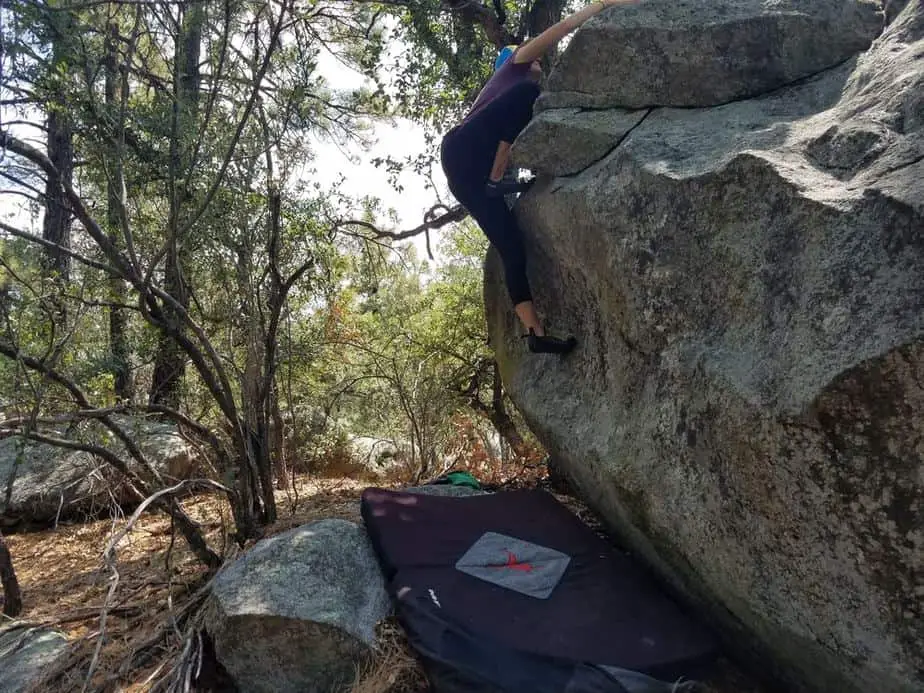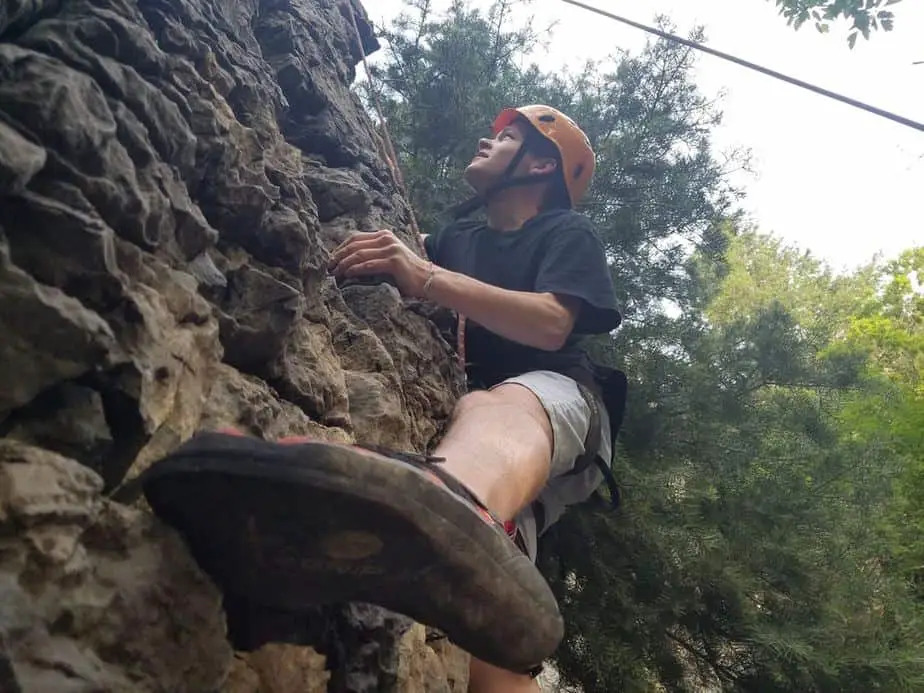If you’re reading this, you probably are experiencing a fair bit of buyer’s remorse right now. You thought you could tough it out until the shoes stretched, but have found that the pain is too much. Leather shoes stretch out up to a full size over time, but everyone says that synthetic climbing shoes don’t stretch.
While synthetic climbing shoes stretch less than leather climbing shoes, they do stretch a little bit. The best way to stretch them out is to climb in them for 2-3 weeks. If you can’t handle that, there are other more drastic methods you can use to stretch them out.
Here are three tried and true methods for stretching synthetic climbing shoes:
- Climb in them for 2-3 weeks, taping hot spots.
- Take a hot shower with the shoes on; then walk around the house stretching your feet as they dry.
- Freeze bags of water in your shoes overnight to expand them.
Synthetic shoes do stretch a little bit, as seams expand and rubber molds around your foot. Just how much and how do do it best we’ll go through below.
3 Methods for Stretching Synthetic Climbing Shoes
The three main ways to stretch climbing shoes should be done in order. If you can get them to stretch out naturally over a couple of weeks, that’s best. If they’re still too tight, then try the hot shower or frozen bag methods. What you don’t want to do is stretch them out too much that they become loose (not likely with synthetics).

Method 1: Stretch Shoes by Climbing in Them
Climbing puts a lot of stress on the materials that make up the climbing shoes. You go from putting all of your weight on your heels to all of your weight on your toes to all of your weight on an inside edge. Climbing cracks puts some pressure on the top and bottom simultaneously.
All of these forces, especially with your feet flexing and stretching as you go, work to slowly stretch out synthetic shoes and mold them around your foot. No shoe fits exactly perfect, so as they mold around your feet it will feel as if they’re stretching out.
It might be miserable to climb for a couple of days, but it will usually ease up after a few sessions. Fortunately, there are some things that you can do to help ease the pain of the first few days:
- Clip your toenails short so that there aren’t sharp edges that can hurt your other toes. Don’t go too short, or they can get ingrown.
- Wrap climbing tape (athletic tape) around hot spots on your feet like the joint on your big toe or middle toe, or the back of your heel.
- Warm up your shoes before climbing in them- tuck them under your armpit, hold them in front of the heater in the car, or tuck hand warmers in them. This makes them more pliable and more comfortable.
- Climb in the morning because your feet swell throughout the day.
- Put your feet into plastic baggies (like socks) before putting your feet in your shoes. This helps your feet slide around more and reduces hot spots.
Wearing them for a few weeks will only get you so far- maybe a half size at most with synthetic shoes. The main thing that happens is the shoe molds around your feet better. If you really need to stretch them, try another method.

Method 2: Stretch Shoes by Showering in Hot Water
Heat, especially UV rays, can damage the rubber on climbing shoes, so it’s important to do this with water and not to get too hot (if your skin can handle it, the shoes are fine). Hot water helps to make the rubber more pliable and the synthetic uppers more likely to stretch.
If you aren’t careful, you can really mess up your shoes. Mold grows easily if you don’t dry them completely, and drying them out too much with the sun or really hot air can crack the rubber. It’s important to do it right.
- Wait until no one is home, because showering with climbing shoes on is weird.
- Take a hot shower or soak your feet for a few minutes in a hot bath. It’s important that your shoes are in the shoes, because they need to mold to your feet.
- Towel off the outside of the shoes and then wear them as they dry out for an hour or so. Aggressive shoes aren’t as comfortable, so you might not be able to walk around in them and may just have to read a book or watch a movie.
- Ideally, you should climb in the shoes as they dry out. Obviously this only works if you’ve got a home gym or nearby crag. Don’t wear soggy shoes to your local bouldering gym!
- Remove the shoes and stuff newspaper into them. This helps them dry out completely, as the paper absorbs any water in the shoe. Don’t store them in the dark since they can get mold, but don’t put them in direct sunlight either.
- Once they’ve dried out completely, you should be able to tell that they fit your feet better and have stretched out a bit.
With unlined leather shoes, this method can add as much as a full size or more to your climbing shoes. For synthetic shoes, you might get up to a half size. The real benefit is that the shoe will mold to your foot better and you’ll be more comfortable.
Method 3: Stretch Shoes by Freezing Bags of Water in Them
If you can’t get a hot shower with some privacy, you can try expanding the shoes in the freezer. The nice thing about doing it this way is that you can do it a couple of times with the shoes laced tighter and tighter and get a more gradual stretch.
- Eat the leftover ice cream to clear space for your shoes in the freezer.
- Fill up ziploc bags with water until they’re full enough to simulate your foot in your shoes. Don’t overfill them, or you’ll be cleaning up a big mess.
- Tuck the bags of water into the shoes, lace up the shoes to the desired level of tightness, and leave them in the freezer overnight.
- Allow shoes and ice to thaw. Once they’ve completely thawed to room temperature, try on the shoes.
- Repeat as necessary, lacing the shoes tighter to get more stretch.
- Make sure to let the shoes dry out completely when you’re done, including any condensation or frost that accumulates
The freezing method helps to stretch out the seams and threads, which makes it work especially well for synthetic shoes. Unfortunately though, the stretch doesn’t mold around your foot like it does for the other methods. I recommend using this method to get a little bit of stretch until it is bearable, and then climbing in them for a few weeks to get them to mold to your feet better.
There’s only so much you can do to stretch your shoes, especially with synthetic bouldering shoes. If you need them to stretch more than a size, you’re probably out of luck and it’s best to try and return them or sell them to someone else (make someone’s day!) rather than wasting your time.
How Much Do Synthetic Climbing Shoes Stretch?
The most synthetic climbing shoes will really stretch is about a half size. This happens as seams stretch out a little bit and the rubber molds around your foot. People say that synthetic shoes don’t stretch, but that’s only partially true. No shoe fits perfectly right at first; there’s always some space to mold around your foot.
If you’re having a hard time getting shoes to fit your right, try out different models and different brands. The shoe’s shape is called a “Last,” and is molded using someone else’s foot. Different lasts will fit different feet better, so you can find something that fits your feet by trying on lots of different shoes.

Related Questions:
Can Climbing Shoes Be Too Small? Climbing shoes are too small when you can’t get up a route without taking them off. If it’s all you’re thinking about as you climb, it’s not worth the pain. Climbing shoes should be tight, but not so tight that it’s something you think about while you are climbing.
Do Black Diamond Climbing Shoes Stretch? Black Diamond’s line of climbing shoes made from synthetic materials do not stretch, despite their appearance. They may look like they are made from the same material as your running shoes, but this is just so that they are breathable. The most they will stretch is a half size due to the rubber molding around your foot during use.
How Long Does It Take For Climbing Shoes to Break In? It usually takes 2-3 weeks to break in a pair of climbing shoes if you are climbing consistently. This means about 8-10 climbing sessions. If you use the hot shower or freezer method, this can be expedited; however there’s no substitute for just doing it the hard way.

